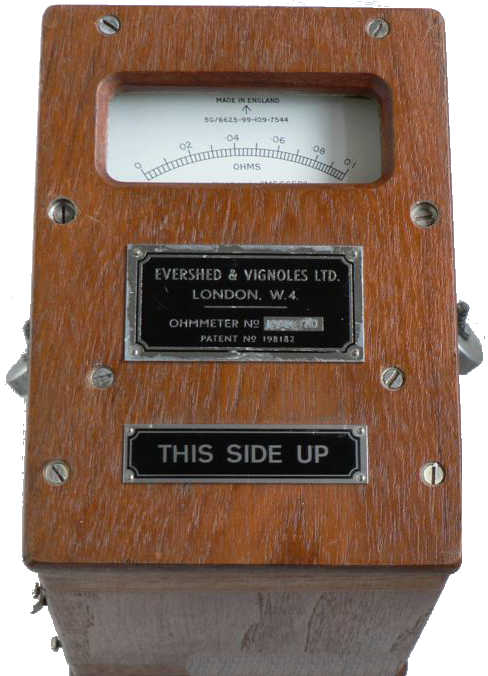
Serial Numbers 1980970 and 5103

Bonding Tester Made by Evershed and Vignoles for the Royal Air force (part number 5G/6625-99-109-7544) Patent 198192 year 1923. Ministry of Defence paperwork inside says it was serviceable and tested in 1991. The instrument is housed in a wooden box with sockets for two probes (part number 5G/5207) and a compartment for a rechargeable alkaline cell. The meter movement has two deflection coils and is similar to that found in insulation testers made by this firm see: megger though in this case a large current provided by a rechargeable alkaline cell is passed through the circuit to be tested and one deflection coil and the voltage developed across the circuit is applied to the other. The instrument can measure from zero to 0.1 ohm.
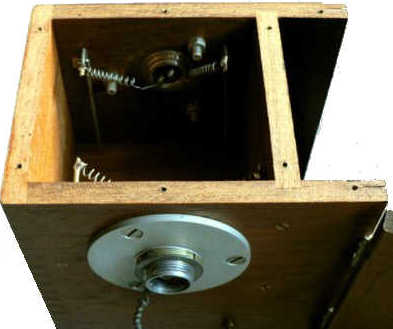
View of interior from below showing probe sockets and battery compartment
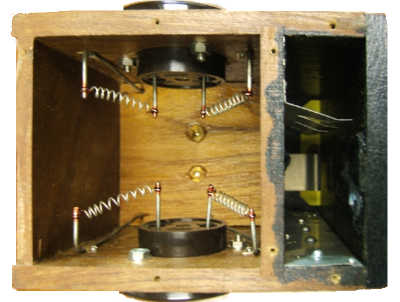
View of interior of an earlier model [serial number 1129366]
This instrument covers a wider range of resistance than mine which was intended to be powered by a single NiFe cell. This one part 5G/433 indicates that it is also an ex Air Ministry instrument but an earlier device than mine which has a NATO part number. I believe the metal plates in the right hand compartment are intended to make contact with four single 1.5 volt cells, connected in parallel.
I have found serial numbers for two more similar instruments: 452049
and 867203 [5G/2126] these both have Bakelite sockets. Incidentally The
5G prefix of the RAF stores reference designates these instruments as
being Special Ground Equipment.
Note that there are what appear to be low value resistors (about
0.01 ohms) in series with each core of the probe leads. What are they
for? I have taken the probe apart to show what is inside. I need
another bonding tester to determine the resistance of the tiny ones you
see here! I imagine that they are designed to compensate for the change
in resistance of the cores of the copper cable with temperature. A
considerable current can flow between the two probes which could warm
the cables and the coils of the meter movement. Those in the box
attached to the rear of the sockets perhaps serve the same function for
the meter movements and internal wiring. The lead I made was from a
piece of 2 core mains cable soldered to a piece of brass rod filed to a
point. Two pins from my scrap box attached to the other end were used
to connect to the other socket.
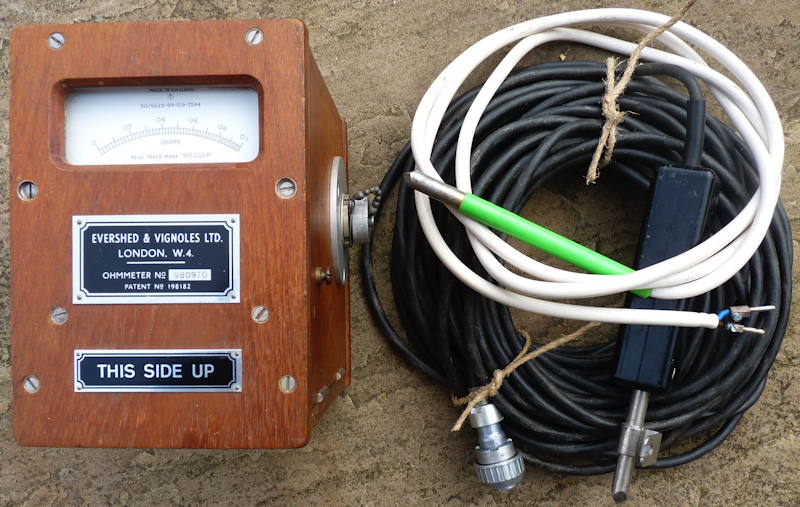

The two core cable is terminated with low resistance wire wound
resistors which are soldered to the substantial probe all housed black
Bakelite handle. Unfortunately I have only one probe and have made
myself another but without the resistors (see picture above).
Nevertheless I have tried the
instrument with an alkaline cell and my homemade probe and have
determined that it works and appears to be accurate. I see now that
perhaps I should have made a probe with two sharpened points as
illustrated in this Air
Ministry document
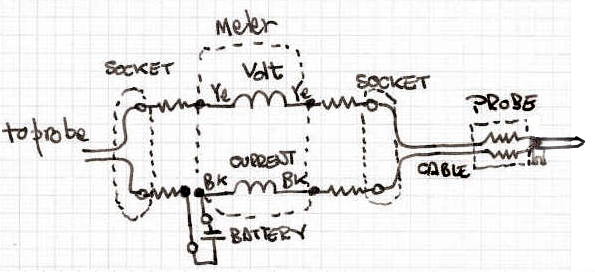
I have been contacted over the years by owners of this and similar instruments with comments queries and suggestions, some of which may prove useful to others.
Colin Ferrier who was an aircraft electrical fitter in the RAF has told me that the bonding tester was used quite frequently to check earth bonding of aircraft, particularly following fitment of new metal parts to aircraft (ailerons, radio trays etc).
Dave Simpson provided details of his non functioning battery as follows:
Evershed & Vignoles Ltd, Megger
Instrument Division,Dover Kent England
Cell voltage nominal 1.2v
Discharge 1.1v, 1.5a load
Fully Charged 1.35 – 1.45v
Nominal capacity 15 amp hrs
Physical size 4’’ x 3’’ x 1’’
Phil
Harris G4SPZ has advised that the Bonding Tester made by Record Electrical Co. Ltd has an
identical-looking meter movement and covers the same range 0.0 to 0.1
ohms. He had to repair one of the ligaments in the movement, a tricky
process but successful in the end, and after a further degree of
'reverse-engineering' the instrument is now fully working, and very
accurate. Record became part of the Thorn Group in 1972 and then part
of Evershed and Vignoles. Initially the two firms worked together and
this instrument had been repaired by E&V. You will note that
this bonding tester has an Air Ministry reference on the scale plate
(A.P.19744) Descriptions of the various forms of the testers made for
the Air Ministry are described in this PDF document.
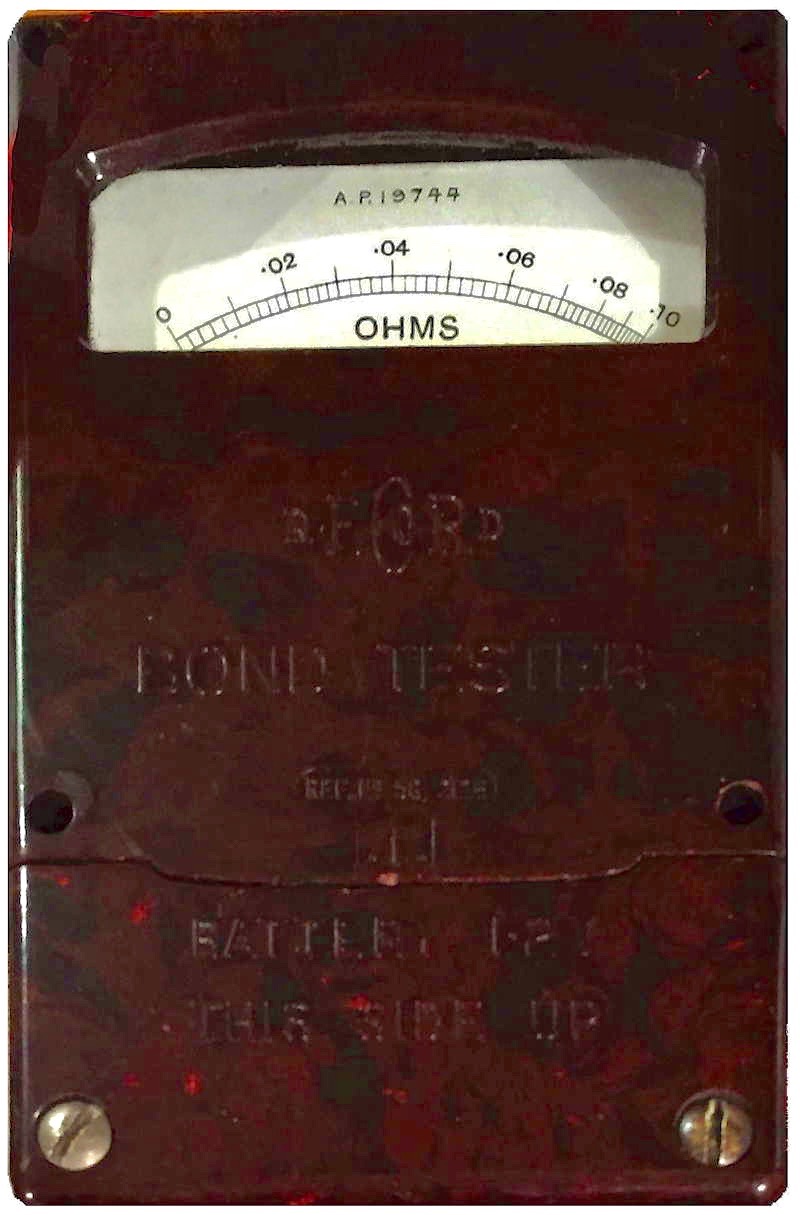
His comments about it are as follows:
For what it's worth, the resistance of the
deflection coil is 1.0 ohm and the control coil measures 60 ohms. The
control coil is shunted by a wirewound resistor of 0.56 ohms, with a
further 0.04 ohms in series with the battery, giving a total of 0.6
ohms. The amount of current injected into the resistance under test is
therefore calculated as a maximum of 2 amps with the probes shorted.
It's not possible to measure this with an ammeter, as the series
resistance of the ammeter is too high.
My instrument came without probes of any kind, so your picture of the
probe plus the circuit diagram were immensely helpful. By a process of
trial and error, I have found that the resistance in the probe feeding
the deflection coil needs to be 1.9 ohms for the meter to read
correctly. The other resistance (in the current path) shown on your
picture must be of such low resistance that it makes very little
difference. I didn't use one in my home-made probe and it doesn't seem
to have upset the accuracy. The sockets are standard 5 amp BS546 plugs,
with only the L & N pins used; presumably the earth pin is there to
ensure the correct polarity. I have read somewhere else that the probes
originally supplied with this and similar instruments had heavy-duty
spikes which rotated as they were pushed onto the test points, and only
then made the connection to the battery. Without this feature, it's
possible to inadvertently connect the current and voltage wires
together which results in the movement violently smacking across the
scale to FSD. Despite having done this a few times, it seems to have
survived. My home-made positive probe now includes a crocodile clip for
the voltage, and a brass wire prod for the current. Clipping the
voltage (deflection) clip in place and then applying the test current
prevents the movement receiving such a shock. I am using a pair of
sub-C 1.2 volt NiMH cells in parallel as the current source.
Phil has described the work he has done on this instrument on the vintage-radio.net website more fully here
History of the E&V and Record
Relationship
In the 1950s Evershed & Vignoles made several acquisitions. The
most significant was the Record Electrical Co Ltd, which had been
founded by
John Westmorland Record in 1911, and was best known for its Cirscale
instruments. J.W. Record was the first person to solve the practical
difficulties of producing an instrument with a scale length double the
diameter of the dial. In many respects, however, Record's company was
in direct competition with Evershed & Vignoles, for it supplied
vast numbers of ammeters and voltmeters to the Royal Navy during the
First World War, and had introduced insulation testing sets in the
twenties. It prospered during the thirties and the Second World war,
and in 1953 added a revolutionary graphic recorder.
The link with Evershed & Vignoles came in 1955. It was all very gentlemanly. This was before managements had been gripped with a passion for rationalisation, and the two firms simply had an interchange of directors and continued to operate as separate entities. This perhaps made sense, for Record Electrical Co was based in Altrincham, Cheshire. Soon, however, it was to be the turn of Evershed Q Vignoles itself. At the company‘s annual general meeting in November 1961, a new chairman was elected to succeed the late Charles Vignoles. It was BQD. Misselbrook, who had already been making frequent visits to the Acton Lane Works. Mr Misselbrook was a director of the British-American Tobacco Co Ltd.
(from an 1983 unpublished history of
Evershed and Vignoles by Roger Woolnough)
How much is it worth? Instruments such as this are of little use today and not many people seem interested in them. Expect to pay �10-�15.

